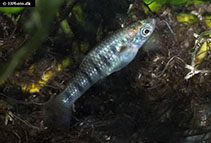| Family: |
Poeciliidae (Poeciliids), subfamily: Poeciliinae |
| Max. size: |
3.3 cm SL (male/unsexed); 3.5 cm SL (female) |
| Environment: |
demersal; freshwater |
| Distribution: |
North America: Haiti. |
| Diagnosis: |
This species is distinguished from all its congeners (Limia sensu lato) except L. nigrofasciata by the following characters: black bars on both sides of the body of males and females (the barred pattern is frequently more conspicuous in this species than in L. nigrofasciata, with darker and wider vertical bars); differs from L. nigrofasciata and other sympatric species (L. grossidens, L. fuscomaculata, L. garnieri, L. immaculata,
L. miragoanensis, L. ornata) in having the origin of the dorsal fin of females slightly posterior to the origin of the anal fin (vs. the origin of the dorsal fin is either slightly anterior or above the origin of the anal fin); differs from all other described species in the genus in having a slender body with body depth approximately equal to the caudal peduncle length; body depth is shorter than caudal peduncle length except in L. nigrofasciata, which has deeper body in relation to the length of the caudal peduncle (more conspicuous in males); number of serrae in the ray 4p of the gonopodium in males (10 segments in all measured specimens); gonapophyses and uncinated processes that support the gonopodium are thicker and more developed (Ref. 128733). |
| Biology: |
Known only from its type locality, the Lake Miragoane in south-western Haiti. It was collected in a small, clear water path exiting the north end of the lake and in the lake itself. However it little else is known about the ecology, but it seems that it prefers habitats with some submerged vegetation and muddy bottoms. It was sympatric with Gambusia beebei, Nandopsis haitiensis, Limia nigrofasciata, L. garnieri, L. miragoanensis, L. immaculata and some introduced species, such as Oreochromis aureus and Tilapia rendali (Ref. 128733). |
| IUCN Red List Status: |
Critically Endangered (CR); Date assessed: 16 June 2020 (B1ab(iii)+2ab(iii)) Ref. (130435)
|
| Threat to humans: |
harmless |
Source and more info: www.fishbase.org. For personal, classroom, and other internal use only. Not for publication.
